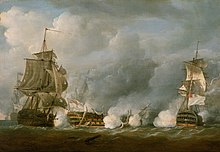
Back حملة الأطلسي في مايو 1794 Arabic Campaña del Atlántico de mayo de 1794 Spanish Campagne atlantique de mai 1794 French Campagna dell'Atlantico del maggio del 1794 Italian 1794年5月の大西洋方面作戦 Japanese
| Atlantic campaign of May 1794 | |||||||
|---|---|---|---|---|---|---|---|
| Part of the naval operations during the War of the First Coalition | |||||||
 HMS Defence at the Battle of the Glorious 1st June 1794, Nicholas Pocock | |||||||
| |||||||
| Belligerents | |||||||
|
|
| ||||||
| Commanders and leaders | |||||||
|
|
| ||||||
The Atlantic campaign of May 1794 was a series of operations conducted by the British Royal Navy's Channel Fleet against the French Navy's Atlantic Fleet, with the aim of preventing the passage of a strategically important French grain convoy travelling from the United States to France. The campaign involved commerce raiding by detached forces and two minor engagements, eventually culminating in the full fleet action of the Glorious First of June 1794, at which both fleets were badly mauled and both Britain and France claimed victory. The French lost seven ships of the line; the British none, but the battle distracted the British fleet long enough for the French convoy to safely reach port.
By the spring of 1794, the French Republic, under the rule of the National Convention, was at war with all its neighbours. With famine imminent, the French Committee of Public Safety looked to France's colonies and the United States to provide an infusion of grain; this was to be convoyed across the Atlantic during April, May and June, accompanied by a small escort squadron and supported by a second, larger squadron in the Bay of Biscay. However, political upheaval had severely reduced the French Navy's ability to fight coherently and supply shortages had devastated its morale, significantly weakening the fleet. Britain, by contrast, was at a high state of readiness with a well-organised command structure, but was suffering from a severe shortage of trained seamen with which to man its large navy. The French Atlantic Fleet, under Admiral Villaret de Joyeuse, was tasked with keeping the British Channel Fleet occupied long enough for the convoy to reach France safely. The Channel Fleet, commanded by Lord Howe, knew of the convoy's passage, and dispatched squadrons to protect British commerce while pursuing Villaret himself with the main body of the Royal Navy's Channel Fleet. For over a week the two battlefleets manoeuvred around one another, Villaret drawing Howe deeper westwards into the Atlantic and away from the convoy. Two partial but inconclusive fleet actions on 28 and 29 May followed, during which Howe seized the weather gage from Villaret, granting him freedom to choose the time and place of his next attack.
The culminating action of the campaign took place over 400 nautical miles (740 km) into the Atlantic, and became known as the Glorious First of June. This final engagement saw Howe use the weather gage to attack Villaret directly while his opponent attempted to fight in a traditional line of battle formation. In the battle, the British fleet inflicted a heavy defeat on the French after a bitterly contested day of fighting. Forcing Villaret to retreat, Howe's force captured seven French battleships, one of which later sank, and inflicted 7,000 casualties on the enemy. Villaret however, claimed strategic success as his delaying tactics had bought enough time for the convoy to reach France safely. The battle was the first in a series of defeats the French Navy suffered during the early years of the war, which bred a defeatist attitude and an unwillingness among the French officer corps to engage the British at sea.